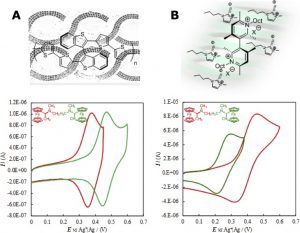Which features should an ideal selector have?
- resulting in discrimination of probe enantiomers in terms of the largest possible peak potential differences, to achieve enantioselective recognition or preparative processes (while in this respect current differences are much less useful!);
- resulting in linear dynamic range for currents, possibly with low LOD, to complement enantiodiscrimination with quantitative analysis and enantiomeric excess estimation (for electroanalysis);
- equal availability of the selector in both enantiomer configurations (an intrinsic advantage of artificial selectors), so that the first ET can correspond to either enantiomer, as desidered;
- general applicability to many probes and operating protocols
- reproducibility and stability
- easy, fast and low-cost preparation
- little selector quantity required, and/or possibility of recycling
Many kinds of chiral surfaces (mostly) and chiral media have been proposed. However, even the most successful approaches did not fully comply with the former “check list” on account of, inter alia:
- poor or labile enantioselectivity;
- difference in current intensity without potential differentiation,
- applicability to a single probe and a single probe enantiomer only,
- sophisticated and expensive preparation procedures, fragile films…
A weak point possibly connected with several of the above problems (in particular, weak and/or labile chirality manifestations) is that the chirality source is not intrinsic to the whole selector, but either localized (for instance, in many chiral polymer films, on stereocentres usually located in external “pendants” rather than in the main electroactive chain) or external (for example, molecular templating agents, chiral media, magnetic fields)
A major breakthrough can come by the use of “inherently chiral” chiral molecular materials, either as electrode surfaces (A) or media (B).
